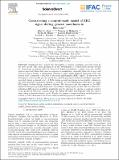| dc.contributor.author | Abel, John H | |
| dc.contributor.author | Badgeley, Marcus A | |
| dc.contributor.author | Baum, Taylor E | |
| dc.contributor.author | Chakravarty, Sourish | |
| dc.contributor.author | Purdon, Patrick L | |
| dc.contributor.author | Brown, Emery N | |
| dc.date.accessioned | 2021-11-22T16:55:19Z | |
| dc.date.available | 2021-11-22T16:55:19Z | |
| dc.date.issued | 2020 | |
| dc.identifier.uri | https://hdl.handle.net/1721.1/138185 | |
| dc.description.abstract | Significant effort toward the automation of general anesthesia has been made in the past decade. One open challenge is in the development of control-ready patient models for closed-loop anesthesia delivery. Standard depth-of-anesthesia tracking does not readily capture inter-individual differences in response to anesthetics, especially those due to age, and does not aim to predict a relationship between a control input (infused anesthetic dose) and system state (commonly, a function of electroencephalography (EEG) signal). In this work, we developed a control-ready patient model for closed-loop propofol-induced anesthesia using data recorded during a clinical study of EEG during general anesthesia in ten healthy volunteers. We used principal component analysis to identify the low-dimensional state-space in which EEG signal evolves during anesthesia delivery. We parameterized the response of the EEG signal to changes in propofol target-site concentration using logistic models. We note that inter-individual differences in anesthetic sensitivity may be captured by varying a constant cofactor of the predicted effect-site concentration. We linked the EEG dose-response with the control input using a pharmacokinetic model. Finally, we present a simple nonlinear model predictive control in silico demonstration of how such a closed-loop system would work. | en_US |
| dc.language.iso | en | |
| dc.publisher | Elsevier BV | en_US |
| dc.relation.isversionof | 10.1016/J.IFACOL.2020.12.243 | en_US |
| dc.rights | Creative Commons Attribution-NonCommercial-NoDerivs License | en_US |
| dc.rights.uri | http://creativecommons.org/licenses/by-nc-nd/4.0/ | en_US |
| dc.source | Elsevier | en_US |
| dc.title | Constructing a control-ready model of EEG signal during general anesthesia in humans | en_US |
| dc.type | Article | en_US |
| dc.identifier.citation | Abel, John H, Badgeley, Marcus A, Baum, Taylor E, Chakravarty, Sourish, Purdon, Patrick L et al. 2020. "Constructing a control-ready model of EEG signal during general anesthesia in humans." IFAC-PapersOnLine, 53 (2). | |
| dc.contributor.department | Picower Institute for Learning and Memory | |
| dc.contributor.department | Massachusetts Institute of Technology. Department of Brain and Cognitive Sciences | |
| dc.contributor.department | Massachusetts Institute of Technology. Institute for Medical Engineering & Science | |
| dc.relation.journal | IFAC-PapersOnLine | en_US |
| dc.eprint.version | Final published version | en_US |
| dc.type.uri | http://purl.org/eprint/type/ConferencePaper | en_US |
| eprint.status | http://purl.org/eprint/status/NonPeerReviewed | en_US |
| dc.date.updated | 2021-11-22T16:50:58Z | |
| dspace.orderedauthors | Abel, JH; Badgeley, MA; Baum, TE; Chakravarty, S; Purdon, PL; Brown, EN | en_US |
| dspace.date.submission | 2021-11-22T16:50:59Z | |
| mit.journal.volume | 53 | en_US |
| mit.journal.issue | 2 | en_US |
| mit.license | PUBLISHER_CC | |
| mit.metadata.status | Authority Work and Publication Information Needed | en_US |
